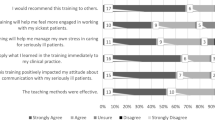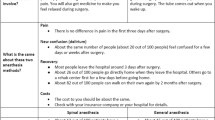Abstract
Purpose of review
The goal of this review is to synthesize a strategy for difficult conversations using evidence from the literature and our experience in surgical and palliative care practice.
Recent Findings
Several published and established resources can inform surgeons’ communication skills. Vital Talk and the Serious Illness Care Program are formal training programs of four days and a half-day in length, respectively, for improving providers’ communication skills. The Best Case/Worst Case tool is a decision aid developed by surgeons for surgeons guiding patients through difficult choices. Published frameworks such as SPIKES and ABCDE outline key steps to navigate challenging conversations and break bad news. Numerous factors contribute to quality of communication, including setting, positioning of participants, open-ended questions, clear and concise language, responding to emotion, and engaging in shared decision-making.
Summary
We describe a strategy for difficult conversations that is tailored for use by surgeons and modeled on surgical principles.
Similar content being viewed by others
References
Papers of particular interest, published recently, have been highlighted as: • Of importance •• Of major importance
Mast MS, Kindlimann A, Langewitz W. Recipients’ perspective on breaking bad news: How you put it really makes a difference. Patient Educ Couns. 2005;58(3):244–51.
∙ Arnold RM, Back AL, Baile WF, Edwards KA, Tulsky JA. The oncotalk/vitaltalk model. Oxford Textbook of Communication in Oncology and Palliative Care. 2017:363. VitalTalk (formerly OncoTalk) is a training program with multi-day workshops, online videos, and a smartphone app that guide providers in developing communication skills.
∙ Bernacki R, Hutchings M, Vick J, Smith G, Paladino J, Lipsitz S et al. Development of the Serious Illness Care Program: a randomised controlled trial of a palliative care communication intervention. BMJ Open. 2015;5(10):e009032. The Serious Illness Care Program provides a half-day training course and a concise pocket guide for serious illness communication.
Bernacki R, Paladino J, Neville BA, Hutchings M, Kavanagh J, Geerse OP, et al. Effect of the serious illness care program in outpatient oncology: a cluster randomized clinical trial. JAMA Intern Med. 2019;179(6):751–9.
∙∙ Taylor LJ, Nabozny MJ, Steffens NM, Tucholka JL, Brasel KJ, Johnson SK et al. A framework to improve surgeon communication in high-stakes surgical decisions: best case/worst case. JAMA Surg. 2017;152(6):531–8. The best case/worst case decision aid is an essential tool made for surgeons by surgeons, outlining a shared approach to making a difficult, complex medical decision based on the patient's values.
∙∙ Baile WF, Buckman R, Lenzi R, Glober G, Beale EA, Kudelka AP. SPIKES—a six-step protocol for delivering bad news: application to the patient with cancer. Oncologist. 2000;5(4):302–11. The SPIKES framework prompts the surgeon to attend to important steps of communication: Setting, Perception, Invitation, Knowledge, Empathy, Strategy/Summary.
∙∙ Rabow MW, Mcphee SJ. Beyond breaking bad news: how to help patients who suffer. West J Med. 1999;171(4):260. The ABCDE framework prompts these key steps of communication: Advance preparation, Build a therapeutic environment/relationship, Communicate well, Deal with patient and family reactions, Encourage and validate emotions.
Friedrichsen MJ, Strang PM. Doctors' strategies when breaking bad news to terminally ill patients. J Palliat Med. 2003;6(4):565–74.
Monden KR, Gentry L, Cox TR, editors. Delivering bad news to patients. Baylor University Medical Center Proceedings; 2016: Taylor & Francis.
Gay EB, Pronovost PJ, Bassett RD, Nelson JE. The intensive care unit family meeting: making it happen. J Crit Care. 2009;24(4):629. e1-. e12.
Weissman DE, Quill TE, Arnold RM. Preparing for the family meeting #222. J Palliat Med. 2010;13(2):203–4.
Tan HM, Wilson A, Olver I, Barton C. The experience of palliative patients and their families of a family meeting utilised as an instrument for spiritual and psychosocial care: A qualitative study. BMC Palliat Care. 2011;10(1):7.
Basu G, Costa VP, Jain P. Clinicians’ obligations to use qualified medical interpreters when caring for patients with limited English proficiency. AMA J Ethics. 2017;19(3):245–52.
Norris WM, Wenrich MD, Nielsen EL, Treece PD, Jackson JC, Curtis JR. Communication about end-of-life care between language-discordant patients and clinicians: insights from medical interpreters. J Palliat Med. 2005;8(5):1016–24.
Bruera E, Palmer JL, Pace E, Zhang K, Willey J, Strasser F, et al. A randomized, controlled trial of physician postures when breaking bad news to cancer patients. Palliat Med. 2007;21(6):501–5.
Weissman DE, Quill TE, Arnold RM. The family meeting: starting the conversation #223. J Palliat Med. 2010;13(2):204–5.
Smith RC, Hoppe RB. The patient's story: integrating the patient-and physician-centered approaches to interviewing. Ann Intern Med. 1991;115(6):470–7.
Rawlings D, Tieman JJ, Sanderson C, Parker D, Miller-Lewis L. Never say die: death euphemisms, misunderstandings and their implications for practice. Int J Palliat Nurs. 2017;23(7):324–30.
Buckman RA. Breaking bad news: the SPIKES strategy. Community Oncol. 2005;2(2):138–42.
Morse JM. Responding to the cues of suffering. Health Care Women Int. 2000;21(1):1–9.
Back AL, Arnold RM. “Isn't there anything more you can do?”: when empathic statements work, and when they don't. J Palliat Med. 2013;16(11):1429–32.
Munoz Sastre MT, Sorum PC, Mullet E. Breaking bad news: the patient's viewpoint. Health Commun. 2011;26(7):649–55.
Barry MJ, Edgman-Levitan S. Shared decision making—The pinnacle of patient-centered care. N Engl J Med. 2012;366(9):780–1.
Weissman DE, Quill TE, Arnold RM. The family meeting: end-of-life goal setting and future planning #227. J Palliat Med. 2010;13(4):462–3.
Kruser JM, Nabozny MJ, Steffens NM, Brasel KJ, Campbell TC, Gaines ME, et al. “Best Case/Worst Case”: Qualitative Evaluation of a Novel Communication Tool for Difficult in-the-Moment Surgical Decisions. J Am Geriatr Soc. 2015;63(9):1805–11.
Lakin JR, Block SD, Billings JA, Koritsanszky LA, Cunningham R, Wichmann L, et al. Improving communication about serious illness in primary care: a review. JAMA Intern Med. 2016;176(9):1380–7.
Luff D, Martin EB Jr, Mills K, Mazzola NM, Bell SK, Meyer EC. Clinicians’ strategies for managing their emotions during difficult healthcare conversations. Patient Educ Couns. 2016;99(9):1461–6.
Author information
Authors and Affiliations
Corresponding author
Additional information
Publisher's Note
Springer Nature remains neutral with regard to jurisdictional claims in published maps and institutional affiliations.
This article is part of the Topical collection on Surgical Education.
Rights and permissions
About this article
Cite this article
Lin, J.A., Cook, A.C. A Surgeon’s Review for Difficult Conversations. Curr Surg Rep 8, 2 (2020). https://doi.org/10.1007/s40137-020-00247-5
Published:
DOI: https://doi.org/10.1007/s40137-020-00247-5




